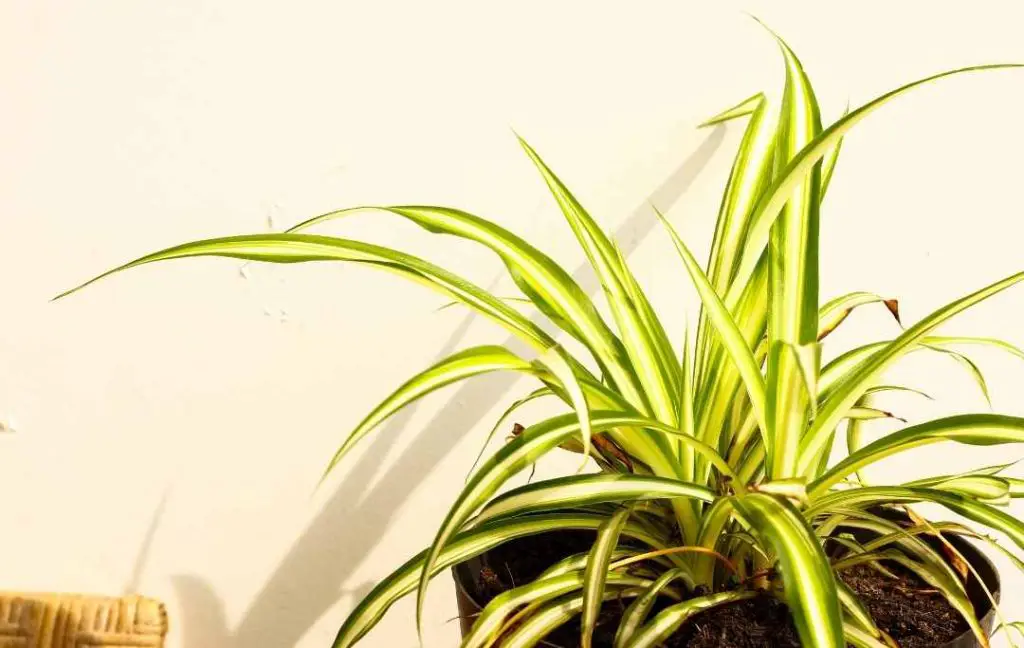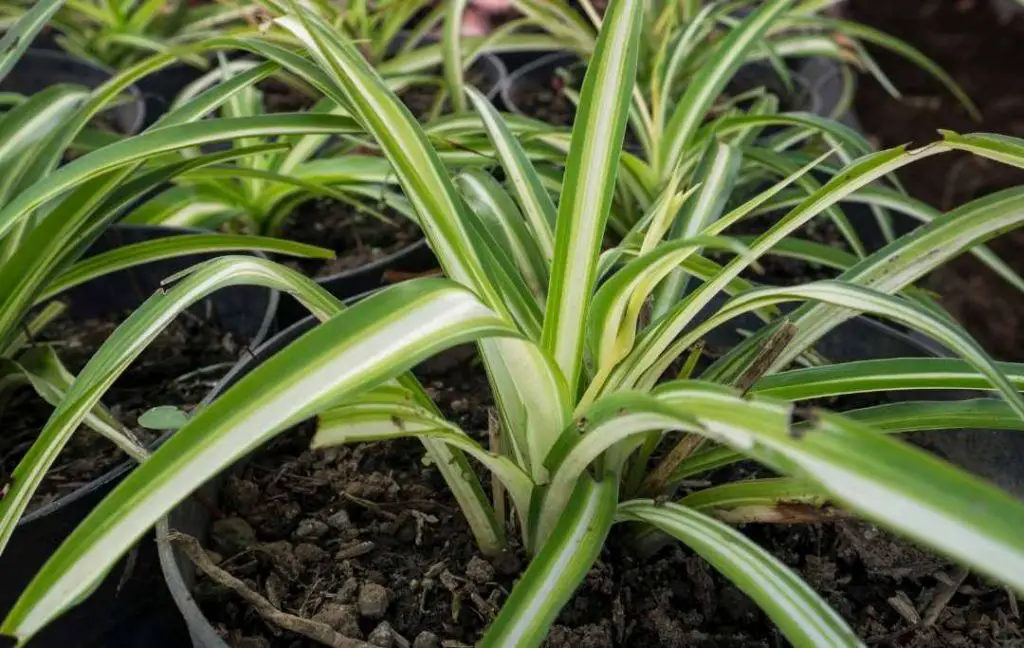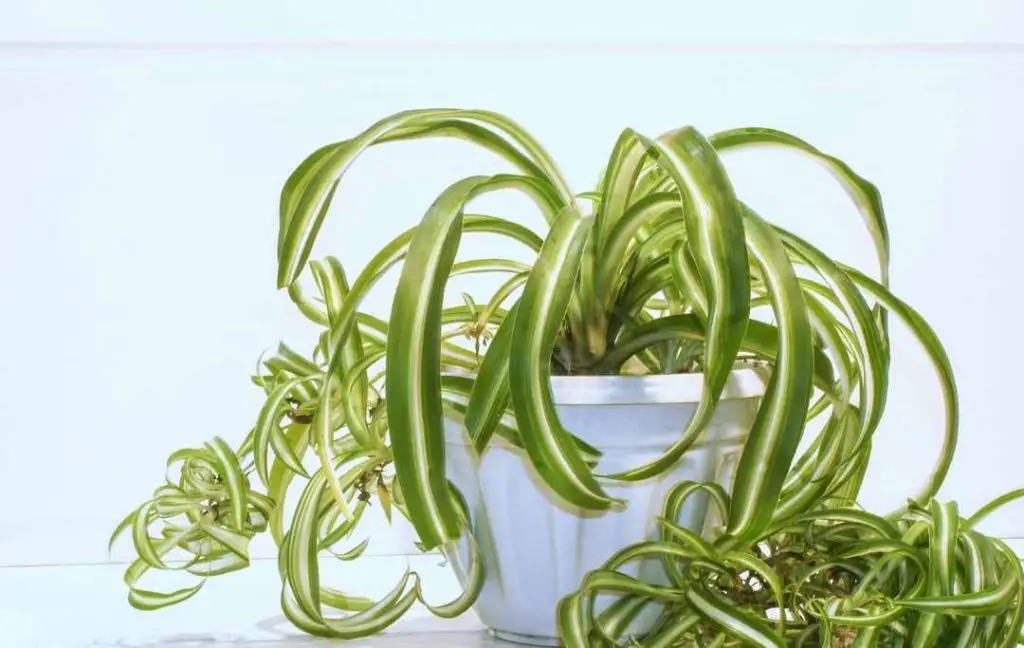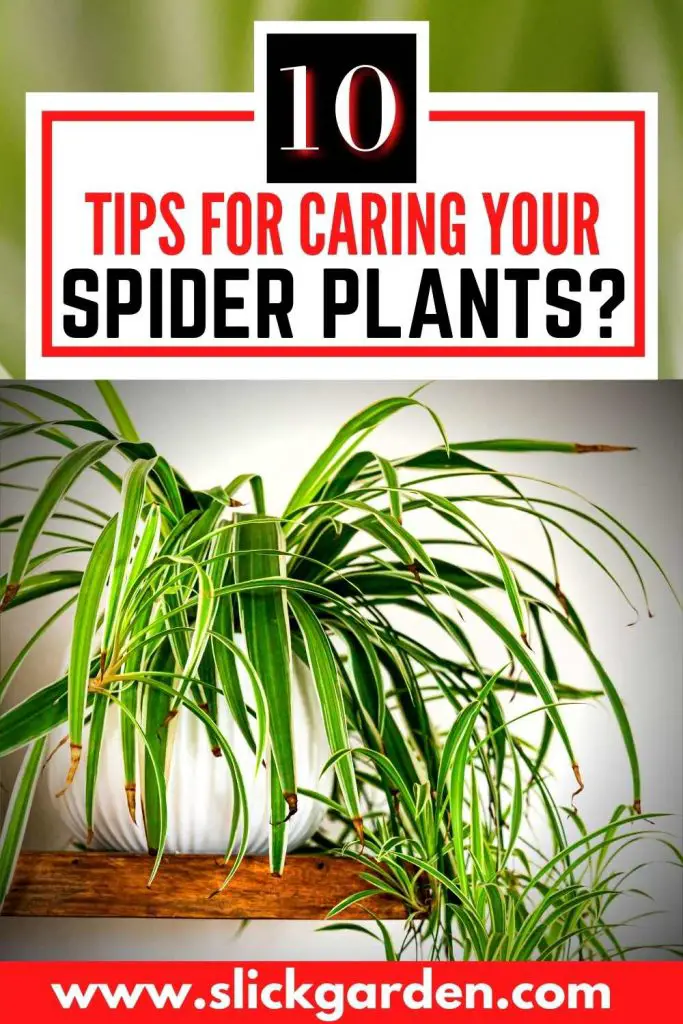If you decide to grow spider plants inside your home, you will see this plant help to purify the air. They can absorb harmful elements from the air. This plant not only enhances the beauty of your living area but will contribute to cleaning your living area’s environment.
Carbon monoxide, xylene, toluene, and formaldehyde are harmful chemicals and spider plants work effectively to remove them. It will help to increase the oxygen level.

The plants in your room help to reduce pain, anxiety, and fatigue. Most people have pets and it is safe for pets. Now we will talk about how to care for your indoor spider plants
SPIDER PLANTS INDOOR CARE
The scientific name of the flowering spider plant is Chlorophytum comosum. This is a perennial plant that has thin and long leaves. The beautiful long grass-like leaves with clusters of small flowers.
The color of flowers is white and spider plants produce flowers in summer. Easy-to-grow and adaptable spider plants are very popular among gardeners.
You can grow spider plants in pots as well as in hanging baskets. Here we are going to share with you some tips for growing indoor spider plants.
1- Recommended Spider Plant Varieties

First You should select the variety which you can grow at your home. Following are spider plant varieties that you can grow indoors.
a- VARIEGATED SPIDER PLANT
It is an evergreen and popular spider plant variety. You can grow it for ornamental purposes; this variety has broad vertical stripes and slightly curved green leaves. You should use well-drained soil in the pot and choose a lightly shaded location.
b- BONNIE
This variety resembles variegated spider plants, the only difference is the leaves have more curls. The leaves can grow up to 8 to 18 inches long. You can grow this plant in your room, compact balcony, or even in bathrooms. This variety also produces very beautiful yellow flowers.
c- ZEBRA PLANTS
This is a fast-growing variety. You can grow them in a hanging basket and they look fabulous. The pot of this plant will become eye-catching in your living area.
d- VARIEGATUM
The curved leaves of this variety have white edges. At the center of the leaves, you will see dark green streaks. You can decorate your living rooms and offices with these beautiful plants.
e- HAWAIIAN SPIDER PLANT
The other name of this variety is Golden Glow. the small and compact size leaves make it a fascinating plant. The height of this plant can be 6 to 12 inches so you can grow them in your living room easily. Moist and well-drained soil is recommended for this variety.
f- VARIEGATED BONNIE SPIDER PLANT
The beautiful arched green leaves have creamy white edges. The beautiful look of this plant makes it perfect for your drawing room. You can also grow it in a hanging basket. This low-maintenance plant is a preferable choice for gardeners.
2- Type Of Soil You Need For Growing Spider Plant
You can use well-aerated potting mixes such as vermiculite or coco coir for growing indoor spider plants. Spider plants live happily in moist soil so never let the soil dry.
Drain is very important so well-drained soil is recommended for your beautiful indoor spider plants. For outdoor spider plants, you can use sandy soil.
3- Choose The Best Location
Spider plants like to grow indirect light that’s why they are the best option as an indoor plant. You can grow them in bathrooms, offices, and bedrooms.
If you want to grow them on windows in the summer or spring season, you should place the pot 12 inches away from the south-facing window.

4- Temperature And Humidity
If you are living in such a climate where temperature and humidity fluctuate, then you should grow your spider plants indoors. The best temperature for them is between 50 degrees Fahrenheit to 80 degrees Fahrenheit.
Spider plants can’t tolerate outside freezing temperatures. A humid environment is best for your spider plants so you should mist their leaves to keep them moist.
You can place a humidifier in your bedroom or the place where you are growing spider plants so you can maintain humidity.
5- Water Requirements For Indoor Spider Plant
Water is a very important factor in the growth of any plant. Here are some tips which you should keep in your mind before watering your spider plants.
- Spider plants are very sensitive that’s why you should not use tap water. The reason is that tap water has fluoride and other minerals which are not good for Spider plants. As a result, your plant will be destroyed. Due to harmful minerals, the spider plants start producing brown leaf tips.
- You should use filtered or distilled water.
- You should use water at room temperature because the hot or cold water can shock your plants. This will also weaken them and stop their growth.
- Before watering your plant you should check the soil with your finger if you see the soil is dry then water it otherwise not. If your finger feels 1 inch of soil is dry it means it is time to water your spider plant.
- During the first year, you should water only once per week. This amount of water is enough to make the soil consistently moist. You need moisture in the soil but not sogginess. Overwatering results in root rot.
Read More
6- How To Fertilize Your Spider?
For better results, you can use a general liquid fertilizer for spider plants during the growing season. You can get all the instructions on the packet of fertilizer.
You should follow the instructions about the quantity of solution you should apply to the soil. You can fertilize 1 to 2 times per month but in spring and summer.
7- Trim Dead Leaves
You should remove the Brown or deadly spider plant. For this purpose, you can use sharp scissors. Your spider plant will focus on growing healthy leaves rather than using their energy for dead leaves.
8- PESTS AND OTHER PROBLEMS
Indoor plants are rarely affected by diseases. Insects and mites are a problem for healthier growth. The common pests are whitefly, spider mites, scares, and aphids. The following are the tips for fighting these little monsters.
- Scales and mealybugs can be removed by using alcohol to take a cotton swab and dip it into alcohol. Now rub the leaves with this cotton.
- You can use natural insecticides for getting rid of these harmful. Neem oil is the best natural insecticide. You can apply a spray of Neem oil on the spider plants. You can buy Neem oil from your local gardening store.
- The other remedy for getting rid of aphids, scale and mealybug is to use a shower of cool or lukewarm water.
- For a heavier infestation, you can also use a spray of insecticidal soap.
Too much water or too little water is the reason for the following problems
Too little water
When you see spider plants are prone to tip burn. The reason for this problem may be dry soil, low humidity, or accumulation of harmful minerals in the soil due to the use of tap water. The soil of spider plants should be kept slightly moist. You should not use fluoridated or chlorinated water.
Too much water
Root rot is another problem that is caused by overwatering. If the soil does not drain quickly or you give more water to your plants then you will face the problem of root rot.

9- Transplant Your Spider Plant When It Outgrows Its Container
If you see the roots of the spider plant start to grow the drainage holes of the pot then it is time to transplant it to a larger pot or container in the spring. You should change the pot according to the size of the plant.
Before replanting, you should fill the new container with fresh potting mix and your container must have drainage holes. Drainage holes are very important for the development of your plant.
10- How To Propagate Spider Plant From A Large Plant
When you see your spider plant has grown too large, you can remove a smaller portion of the plant and re-pot it in a small pot. With time, you have a new beautiful spider plant.
The other way of propagating spider plants is to remove the plantlets from the mother plant and put them in a cup or bowl of distilled water. But make sure water doesn’t reach any leaves.
Change the water daily so you can protect your new plant from bacteria. A few days later, you will see a strong root system emerge from the plantlet. Now you can plant it in the pot.
Read More
